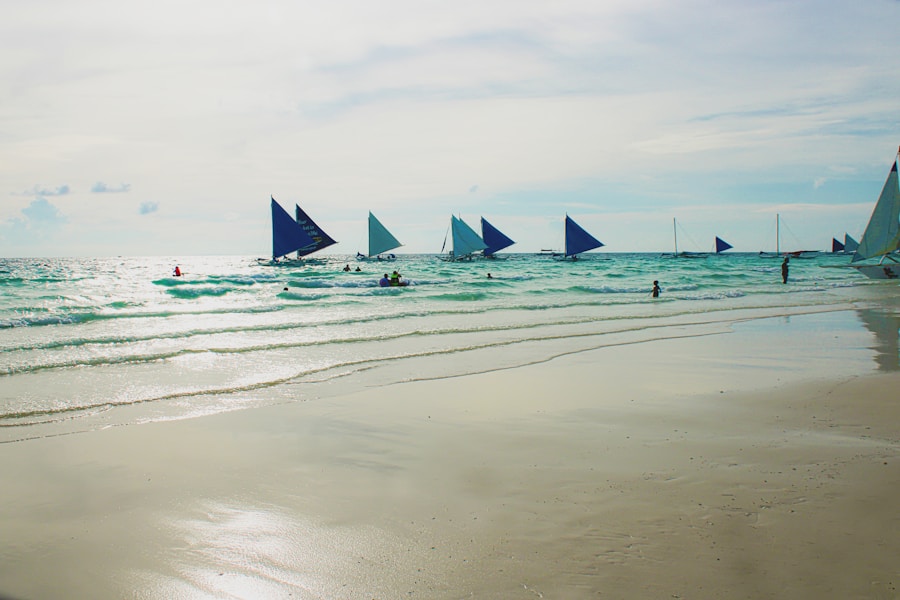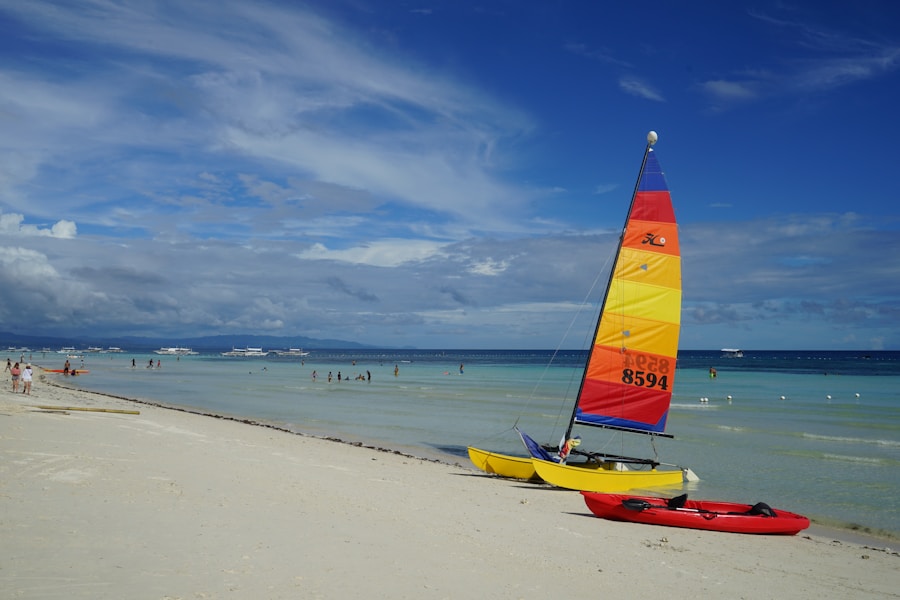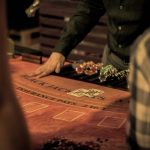Download links
How to install Paradise Found: Exploring the Wonders of Boracay APK?
1. Tap the downloaded Paradise Found: Exploring the Wonders of Boracay APK file.
2. Touch install.
3. Follow the steps on the screen.
Description
Boracay, a small island located in the central Philippines, is renowned for its stunning beaches, vibrant nightlife, and diverse recreational activities. Spanning just about 10 square kilometers, this tropical paradise has become a premier destination for both local and international tourists. The island’s allure lies not only in its natural beauty but also in its rich cultural heritage and the warm hospitality of its residents.
With its powdery white sand beaches and crystal-clear waters, Boracay has earned a reputation as one of the best beach destinations in the world, often appearing on various travel lists and rankings. The island’s transformation from a quiet fishing village to a bustling tourist hotspot began in the late 1970s. Over the decades, Boracay has undergone significant development, with numerous resorts, restaurants, and entertainment venues springing up to cater to the influx of visitors.
Despite this rapid growth, efforts have been made to preserve the island’s natural beauty and cultural identity. The Philippine government has implemented various measures to ensure that Boracay remains a sustainable destination while still providing an unforgettable experience for travelers. This balance between development and conservation is crucial for maintaining the island’s charm and appeal.
Key Takeaways
- Boracay is a popular island destination in the Philippines known for its stunning beaches and vibrant nightlife.
- The island is home to several beautiful beaches, including White Beach, Puka Beach, and Bulabog Beach, each offering unique experiences for visitors.
- Visitors to Boracay can enjoy a wide range of activities and adventures, such as snorkeling, scuba diving, kiteboarding, and island hopping.
- Boracay’s nightlife is lively and diverse, with beachfront bars, nightclubs, and live music venues offering entertainment for every taste.
- The local cuisine in Boracay is a delicious mix of Filipino and international flavors, with fresh seafood and tropical fruits being popular choices for visitors. Sustainable tourism efforts are being implemented in Boracay to preserve the island’s natural beauty and resources for future generations.
The Beaches of Boracay
Boracay is home to several breathtaking beaches, each offering a unique atmosphere and experience. The most famous of these is White Beach, which stretches for approximately four kilometers along the western coast of the island. Renowned for its powdery white sand and turquoise waters, White Beach is divided into several stations, each catering to different types of visitors.
Station 1 is known for its upscale resorts and quieter ambiance, making it ideal for those seeking relaxation. In contrast, Station 2 is the heart of Boracay’s social scene, bustling with shops, restaurants, and bars. Station 3 offers a more laid-back vibe, attracting families and those looking for a peaceful retreat.
Aside from White Beach, Boracay boasts other stunning shorelines worth exploring. Puka Shell Beach, located on the northern tip of the island, is famous for its unique puka shells scattered along the shore. This beach is less crowded than White Beach, providing a serene environment perfect for sunbathing or enjoying a picnic.
Another hidden gem is Bulabog Beach, which lies on the eastern side of the island. Known for its strong winds and waves, Bulabog Beach is a haven for water sports enthusiasts, particularly kite surfers and windsurfers. Each beach in Boracay offers its own distinct charm, ensuring that visitors can find their perfect spot to unwind.
Activities and Adventures

Boracay is not just about lounging on the beach; it offers a plethora of activities and adventures that cater to all types of travelers. For those seeking adrenaline-pumping experiences, water sports abound. Jet skiing, parasailing, and banana boat rides are popular choices that allow visitors to explore the azure waters while enjoying an exhilarating ride.
Scuba diving and snorkeling are also highly recommended, as the surrounding waters are teeming with vibrant marine life and stunning coral reefs. Numerous dive shops offer guided tours to some of the best dive sites around Boracay, making it accessible for both beginners and experienced divers. In addition to water sports, Boracay offers land-based activities that showcase the island’s natural beauty.
Hiking enthusiasts can trek to Mount Luho, the highest point on the island, where they can enjoy panoramic views of Boracay and its surrounding islands. The hike is relatively easy and takes about an hour, making it suitable for most fitness levels. For those interested in exploring the local culture, a visit to the nearby village of Manoc-Manoc provides insight into the traditional way of life on the island.
Here, visitors can interact with locals, learn about their customs, and even participate in community activities such as fishing or farming.
Nightlife and Entertainment
| City | Number of Bars | Number of Nightclubs | Number of Theaters |
|---|---|---|---|
| New York City | 2,000 | 500 | 150 |
| London | 1,500 | 300 | 100 |
| Tokyo | 1,200 | 250 | 80 |
As the sun sets over Boracay, the island transforms into a vibrant hub of nightlife and entertainment. The beachfront bars and clubs come alive with music, laughter, and dancing, creating an electric atmosphere that attracts partygoers from around the world. One of the most iconic nightlife spots is the famous “Happy Hour” at various bars along White Beach, where visitors can enjoy discounted drinks while watching the sunset paint the sky in hues of orange and pink.
For those looking for a more laid-back evening, there are numerous beachfront lounges where one can sip cocktails while listening to live music or enjoying fire dance performances. The lively atmosphere continues into the early hours of the morning at popular nightclubs like Club Paraw and Epic Boracay, where renowned DJs spin tracks that keep revelers dancing until dawn. The nightlife scene in Boracay caters to all preferences; whether one seeks an energetic party or a relaxed evening by the beach, there is something for everyone.
Local Cuisine and Dining
Boracay’s culinary scene is as diverse as its visitors, offering a wide range of dining options that reflect both local flavors and international influences. Seafood lovers will find themselves in paradise with an abundance of fresh catches available at various restaurants along the beach. Grilled fish, shrimp, and squid are staples on many menus, often served with traditional dipping sauces that enhance their flavors.
One must-try dish is “sinigang,” a sour soup made with tamarind and various meats or seafood that showcases the rich culinary heritage of the Philippines. In addition to local fare, Boracay boasts a variety of international cuisines that cater to diverse palates. From Italian trattorias serving homemade pasta to Japanese sushi bars offering fresh sashimi, visitors can indulge in flavors from around the globe without leaving the island.
Food markets also provide an opportunity to sample street food delicacies such as “isaw” (grilled chicken intestines) or “kwek-kwek” (quail eggs coated in orange batter). Dining in Boracay is not just about satisfying hunger; it’s an experience that allows travelers to immerse themselves in the island’s vibrant culture through its food.
Sustainable Tourism in Boracay

In recent years, Boracay has faced challenges related to over-tourism and environmental degradation. In response to these issues, the Philippine government implemented a six-month closure of the island in 2018 to rehabilitate its natural resources and infrastructure. This initiative aimed to restore Boracay’s pristine environment while promoting sustainable tourism practices that would benefit both visitors and residents alike.
Sustainable tourism in Boracay focuses on preserving its natural beauty while ensuring that local communities thrive economically. Many resorts have adopted eco-friendly practices such as waste management systems, water conservation measures, and renewable energy sources. Additionally, initiatives promoting responsible tourism encourage visitors to respect local customs and minimize their environmental impact during their stay.
Tourists are urged to participate in beach clean-ups or support local businesses that prioritize sustainability. The future of Boracay hinges on finding a balance between tourism development and environmental preservation. By embracing sustainable practices and fostering community involvement, Boracay aims to remain a beloved destination for generations to come while safeguarding its unique ecosystems and cultural heritage.
As travelers increasingly seek destinations that prioritize sustainability, Boracay’s commitment to responsible tourism positions it as a model for other tourist hotspots around the world.
If you’re planning a trip to Boracay, you may also be interested in checking out the article “Keajaiban TG777: Menikmati Sensasi Sepak Bola” on TG777. This article discusses the wonders of TG777 and the excitement of enjoying soccer sensations. It’s a great way to unwind and have fun before or after your beach vacation in Boracay.
FAQs
What is Boracay?
Boracay is a small island in the Philippines known for its beautiful white sand beaches and clear blue waters. It is a popular tourist destination for its stunning natural beauty and vibrant nightlife.
What are the popular activities in Boracay?
Some popular activities in Boracay include swimming, snorkeling, scuba diving, kite surfing, and island hopping. The island also offers a variety of restaurants, bars, and shops for visitors to enjoy.
When is the best time to visit Boracay?
The best time to visit Boracay is during the dry season, which runs from November to April. This is when the weather is most pleasant and the waters are calm, making it ideal for beach activities.
How do I get to Boracay?
Visitors can fly into either Kalibo International Airport or Caticlan Airport, and then take a boat to Boracay. There are also direct flights to Caticlan from Manila and other major cities in the Philippines.
Is Boracay a family-friendly destination?
Yes, Boracay is a family-friendly destination with plenty of activities and accommodations suitable for families. The island offers a range of options for visitors of all ages, including kid-friendly resorts and calm swimming areas.
Are there any environmental regulations in place in Boracay?
Yes, in 2018, the Philippine government closed Boracay for six months to undertake a massive rehabilitation effort to address issues such as overdevelopment, pollution, and overcrowding. Since then, the island has implemented strict environmental regulations to ensure its sustainability and protection.





